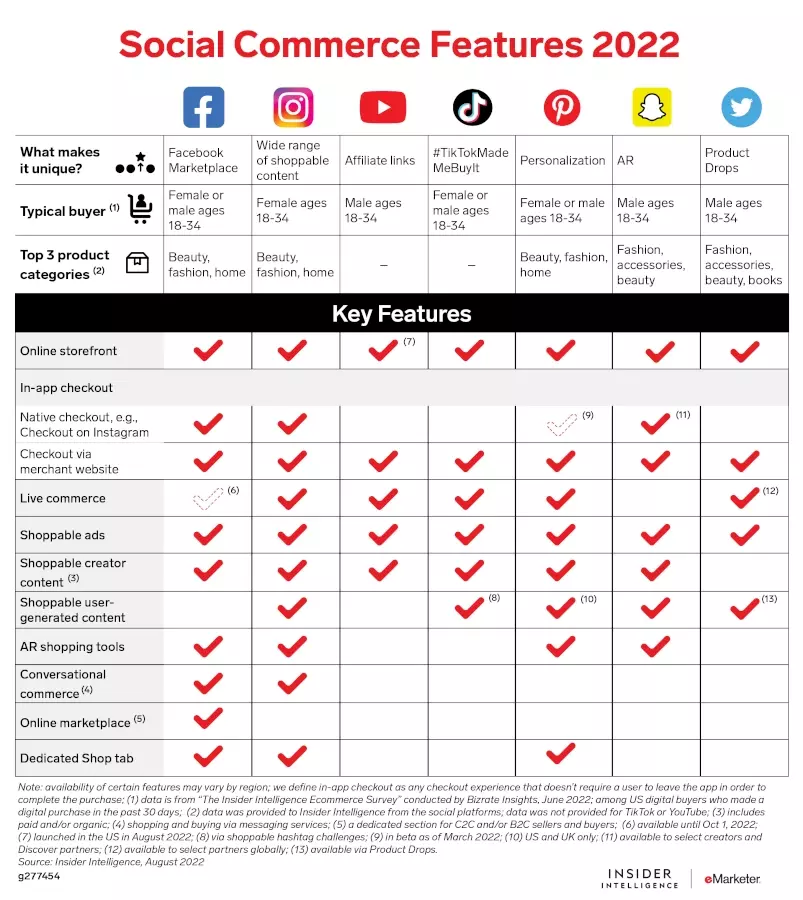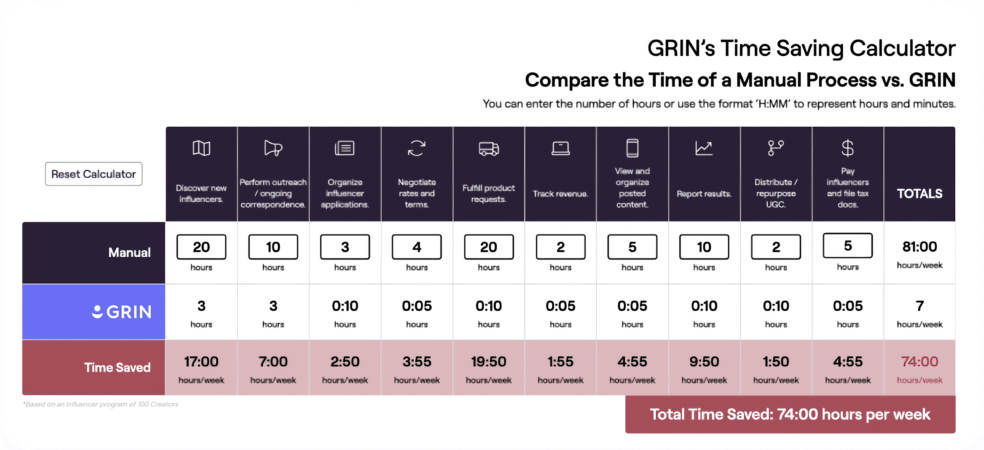Ecommerce revenue has increased by at least $100 million year over year since 2019. And by 2024, researchers predict there will be more than $1 trillion to go around for companies in the United States alone.
So how are you planning to carve out a larger slice for your brand?
We’ve compiled a list of our top tips to keep you up to speed with evolving trends in the ecommerce landscape and get your gears churning into the new year and beyond.
The 25 best ecommerce marketing strategies for brands in 2024
1. Take advantage of social commerce features.
While consumers have traditionally used social media to learn about new products, new social commerce features make it simple to discover and buy without leaving an app.
Research shows that about 97 million social media users took advantage of social commerce features in 2022. And as platforms continue to develop new and innovative ways for shoppers to complete purchases in-app, that number should rise to about 144 million by 2025.
Here is a look at some current social commerce features by platform:

2. Make TikTok a priority.
In 2019, TikTok accounted for just 2.3% of U.S. spending on creator campaigns. This year, it will surpass Facebook and boast a 15.5% market share. With a power algorithm serving as a launchpad for countless viral shopping trends, TikTok’s meteoric rise is one that influencer marketing managers simply can’t ignore if they want to stay relevant in 2024.
3. Embrace augmented and virtual reality technology.
Virtual reality (VR) and augmented reality (AR) have opened up endless possibilities for marketers in recent years. As platforms like Instagram, Facebook, Snapchat, and Pinterest continue to hone their capabilities, brands can create memorable customer experiences and help consumers see products in a completely new light.
Plus, with deliveries of AR and VR devices expected to increase nearly 800% by 2026, now is the perfect time for innovative marketers to begin experimenting with the emerging trend.
“Hopefully, this is the year when AR and VR take a big step up because we kind of have to think outside the box. We get tired of the same old thing.” — OneDash Founder and CEO Rayhan Perera, from the GRIN Gets Real podcast
4. Emphasize retargeting.
When consumers show interest in your products and services, you should take every opportunity to retarget them after the initial point of sale. The two groups you’re most likely to find success retargeting are:
- Consumers who left an item in their shopping cart – Roughly 83% of consumers are willing to share personal details in exchange for a more personalized shopping experience. Take advantage of this opportunity and ask for an email address so you can follow up if they don’t complete a purchase the first time.
- Consumers who have already bought from you – These people have already proven they’re willing to give your products a try. Be sure to ask for feedback on their purchase and follow up with them on any new products you think they could be interested in.
5. Personalize your marketing emails.
Even if you’re sending automated email sequences to hundreds of prospects at once, adding a personal touch wherever possible goes a long way to making sure the recipient feels like more than just a number.
Here are a few strategies to consider:
- Segmentation – Segment your email list based on gender, location, role, etc. Even using a small amount of available data can help add a personal touch that makes the recipient feel like the message is tailored specifically for them.
- Emails from a person – Make sure your emails come from a person within the organization rather than the business itself. This will make the correspondence feel less like a “marketing email” and more like a conversation.
- Celebrate anniversaries – Keep a list of your customer’s birthdays or other important dates. A simple message commemorating an anniversary is a small gesture that goes a long way.

6. Implement SEO best practices.
Search engine optimization (SEO) is still one of the most tried and true methods for getting discovered online. Without a strong grasp of best practices, you’ll likely be shooting in the dark with all the amazing content you produce.
Here are some best ways to win over Google’s site crawlers:
- Produce blogs and educational resources on your site with high-ranking keywords.
- Create compelling title tags and meta descriptions.
- Optimize images for search.
- Optimize page loading speed.
- Add internal links from top-ranking pages on your site.
- Go after authoritative backlinks.
- Create useful content.
7. Start an affiliate program.
Because of a performance-based structure that rewards creators who drive conversions, affiliate marketing is one of the most effective and cost-efficient strategies for ecommerce brands. As such, 81% of brands implemented an affiliate program in 2021. Collectively, those creators generated roughly 5 billion clicks, leading to more than 170 million completed transactions worldwide.
8. Leverage user reviews.
From purchasing a new car to deciding which restaurant to eat at on the drive home from the dealership, user reviews provide the social proof necessary to influence purchase decisions at every turn. In fact, 90% of consumers say an online review is just as important as a personal recommendation.
With that in mind, brands need to make it easy for their customers to leave positive reviews. It also wouldn’t hurt to offer some kind of incentive for them to do so.
9. Create an ‘experience.’
Ecommerce brands need to do more than neatly showcase their products and services on their website and social media channels if they want to stand out from competitors in 2024. By executing an effective experiential marketing campaign, you can give consumers a memorable encounter that helps build a deeper connection with your brand and encourages people to share that positive experience with others.
These events can be virtual or in-person as long as you encourage meaningful interactions between your employees and target audience. And if you’re already working with creators, you’ll see even better results when you recruit them to help plan and host the party.
10. Feature user-generated content (UGC).
Scrolling through social media to find real people tagging your company and spreading positive vibes for your brand can uncover a treasure trove of user-generated content you can use to create social proof for your products. To encourage UGC, consider making unique hashtags your fans can use to show you love. Just be sure to obtain all the necessary content rights before repurposing the content in other avenues.
11. Use keywords to produce a FAQ section on your website.
Always do a quick keyword search before filling out your FAQ section. Incorporating high-ranking phrases into the content is a sneaky way to grab more attention from search engines, not to mention the internal linking opportunities if you use your FAQs to navigate users elsewhere on your site.
12. Create unique and educational content.
Help consumers build a stronger connection to your shared community. For example, a beauty brand might give customers examples of their favorite seasonal style trends, while a fitness brand could provide resources for a more effective workout routine. Give your audience something actionable they can implement into their daily lives. Then show them how your brand can help them reach their goals.
13. Offer incentives.
No matter your conversion goal, it never hurts to incentivize your audience to take action. Whether it’s a welcome gift, membership discount, contest entry, or whatever else might pique your audience’s interest, a small gesture can go a long way to creating a loyal fan.
14. Optimize for mobile.
In 2020, 61% of web traffic came from mobile devices, while 36% came from desktops (tablets had the last 3%). And as more social platforms begin to offer in-app shopping, ecommerce brands can expect to see more and more of that traffic headed to their front door. Offering a seamless mobile experience will ensure shoppers stay on your site and don’t jump ship for a more intuitive framework.
15. Humanize your brand.
Everyone has an origin story, and revealing yours gives audiences a chance to learn more about your brand and products in a fun and natural way. Plus, putting a face to your company and adding a human touch helps consumers build a deeper connection with you and your brand community.
“Storytelling is the art of expressing who you are and what you stand for … Share those values on your website, branding, design, and everything else marketing-related.”
— Movetic CEO Josh Roush, from the GRIN Gets Real podcast
16. Implement a full-funnel marketing approach.
At the end of the day, we’re all here to make money. But it’s easy to get distracted by sales and ignore the small steps you must take to maximize your earning potential. Remember, a comprehensive marketing strategy takes into account every stage of the marketing funnel.
- Awareness – Introduce your brand to new audiences and broaden your reach.
- Consideration – Stay front-of-mind with your audience and educate them on your products.
- Conversion – It’s time for your audience to take action.
- Loyalty – Turn your customers into dedicated brand fans.
- Advocacy – Turn your dedicated fans into brand champions.
Listen to Our Episode: Creating a full-funnel approach to influencer marketing on the GRIN Gets Real Podcast
17. Provide amazing customer service.
Again, it’s all about building relationships. Having the right people in the right place to answer questions or turn a frustrated shopper into a happy customer is invaluable to any brand. Remember that for many, this could be the only 1:1 interaction they have with your company, so a positive encounter is essential.
18. Build your ideal customer persona.
Do you know the exact kind of person interested in your product? Even if you think you do, take some time to really hash out the details.
Here are a few questions to help get you started:
- How old are they?
- Where do they live?
- What is their personality type?
- What are their goals?
- What are their pain points?
- What motivates them?
- Where do they spend time online?
19. Increase sustainable practices.
Today’s consumers—especially Gen Z and millennials—hold brands to a higher standard regarding ethical and sustainable business practices. From committing proceeds to charitable causes to rethinking product and packing materials, there are plenty of steps your brand can take to keep pace with evolving sentiments.
But when it comes to product selection, here’s a look at which features were most important to U.S. shoppers in 2022.
- 24% wanted a selection of products free of harmful or synthetic materials.
- 18% looked for products with sustainable packaging.
- 16% preferred locally sourced products.
- 14% wanted tags and filters for environmentally sustainable products.
20. Experiment with subscription boxes.
Box subscription services are now more common than ever in the ecommerce landscape. In fact, more than 70% of consumers say they have tried a box subscription service, and more than 65% say they renewed their subscription after its first use. If you can find a way to make your inventory compatible with the service, 2024 would be a great time to give it a shot.
21. Become an expert on the creator economy.
Influencer marketing is now an industry worth just north of $5 billion. The staggering figure has many brands increasing their creator budgets in 2024, while countless others will experiment with the strategy for the first time.
But despite the burgeoning industry, true “experts” on the creator economy are still few and far between. By establishing yourself as an authority in what it takes to be successful in the space, you’ll become an invaluable asset to your brand and gain a competitive edge over other players in your niche in the coming year.
22. Partner with authentic content creators.
Anyone can find an influencer willing to partner with them. The key is finding authentic creators who love your brand, use your products, and genuinely believe in both.
Finding the right creator also means partnering with someone who has a genuine connection with an audience that trusts them when they give honest product endorsements. This means looking beyond vanity metrics like follower count and zeroing in on creators who know how to generate strong engagement with their fans.
See Also: How to Find Influencers Guidebook
23. Reach out to nano and micro influencers.
Speaking of loyal fans, no one has a more engaged audience than nano and micro influencers. Not only do they boast the highest engagement rates of any creators on average, but they are also more likely to accept product gifting and commission-based payment models, making them far more affordable options than the macro and celebrity influencers requiring massive flat rates.
24. Nurture long-term creator relationships.
One-off partnerships still have their place in creator marketing, but a long-term, high-performing creator who knows the ins and outs of your brand and can share your story passionately and accurately can be one of the most powerful assets at your disposal.
But remember, you should treat creators as trusted partners—not transactions. As such, staying open to feedback and offering ample creative freedom will go a long way to nurturing relationships that last.
25. Invest in creator management tools.
We’ve mentioned how critical partnering with authentic creators, leveraging nano and micro-influencer content, and focusing on building long-term relationships will be in 2024. But you’ll need to scale your program with as many of these creators as possible to really reap the benefits.
However, accomplishing your goals with a manual approach is a headache. But GRIN developed the world’s first Creator Management platform to ease your pain.
From vetting potential partners and organizing influencer-generated content to communicating with creators at scale and analyzing campaign performance down to the cent, GRIN brings all the tools and information you need into one easy-to-use platform. At the end of the day, you’ll have all the time you need to nurture lasting relationships with your favorite creators and focus on the big-picture vision for your brand.
Key takeaway: Authentic content creators will help elevate your entire ecommerce marketing strategy in 2024.
As marketers, we’re always looking for what’s next to stay on the cutting edge of our industry. Keeping up with and capitalizing on emerging trends and leveraging authentic content creators to help you launch the next big thing will put you in the best position to succeed in 2024.
Are you ready to stake your claim in the creator economy? Discover more helpful tips and resources from the experts at GRIN: Creator Management Learning Center

















